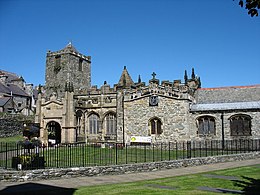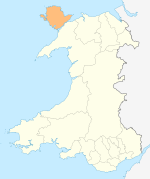| Caer Gybi | |
|---|---|
| Anglesey, Wales, UK | |
 Roman Wall surrounding St Cybi's Church | |
Location in Anglesey | |
| Coordinates | 53°18′42″N 4°37′58″W / 53.3118°N 4.6328°W |
| Grid reference | SH247826 |
Caer Gybi was a small fortlet in Roman Wales in the Roman province of Britannia Superior. Its name in Latin is unknown. Today it stands at the centre of Holyhead in the Welsh county of Anglesey. Holyhead is named Caergybi in Welsh, after the fort.
The fort is one of Europe's only three-walled Roman forts. The fourth side fronted the sea and was probably the site of a quay. Its date is unknown, but it is generally thought to be part of a late-4th-century scheme, associated with Segontium, which was used to defend the west coast against Irish sea-raiders. The Romans also built a watch tower, within Mynydd y Twr on the top of Holyhead Mountain, which was almost certainly used as the fort's look-out point. Both were possibly abandoned around 393, when the troops were sent to respond to the revolt of Eugenius of Gaul.
In the 6th century, the old fort was given to Saint Cybi, who founded a monastery there. The Church of St Cybi still stands on the site today, with a small detached chapel (Eglwys y Bedd) that reputedly stands over Cybi's grave.
References
[edit]- Arnold, Christopher J; Davies, Jeffrey L (2000). Roman & Early Medieval Wales. Stroud: Sutton Publishing.
External links
[edit]


Well, that’s interesting to know that Psilotum nudum are known as whisk ferns. Psilotum nudum is the commoner species of the two. While the P. flaccidum is a rare species and is found in the tropical islands. Both the species are usually epiphytic in habit and grow upon tree ferns. These species may also be terrestrial and grow in humus or in the crevices of the rocks.
View the detailed Guide of Psilotum nudum: Detailed Study Of Psilotum Nudum (Whisk Fern), Classification, Anatomy, Reproduction